It snows in Shanghai! Heavy snow since abou 10:00 AM to now (3:09 PM).
Monthly Archives: December 2009
Freezing Winter for Internet in China
My friends Lv Xinxin comes from Beijing today and we had a nice lunch with other friends from websites. We chatted a lot about the status of many of our friends – most of them run websites.
Xinxin brought me back to the year of 2005. I said so, because 2005 is the Spring for Internet in China. The global Internet recovered from the Internet bubble crisis in 2003 to 2004, and in China, the real beginning was 2005. Many websites emerged at that time, and we had interesting gathering so frequently at that time. I got to know Xinxin at that time, and I got to know many of my current friends in the Internet space in that year.
In 2006, people were busy developing their sites, and in 2007, many of them faced big challenge in both financial sides, and from business model side. In 2008, I started to hear bad news of shutdown of websites. Many of others were just trying very hard to keep their head above the water. In 2009, it is the end of many sites. Many sites went bankrupt due to financial reasons – very reasonable, but to my greatest angry, many of them were shutdown in this new round of Internet cracking down.
Today, I heard some other bad news about websites.
It is obvious to me that THEY are tightening the Internet control. There are rumor that they will implement something called “whitelist” for Internet sites outside China. The rumor was, only those sites who register with the Chinese government can be accessed by people in China. I just don’t believe it. It is so naive to think about this idea, but many naive, and impossible measures were already taken that I am not 100% sure that they won’t do stupid things like this.
Merry Christmas 2009
Merry Christmas!
There is not too much Christmas feeling this year. Does anyone feel the same? I just feel this Christmas in Shanghai is a pretty plain and simple holiday, unlike other Christmas.
Anyway, for all my friends who celebrate Christmas, Merry Christmas, especially to my friends outside Shanghai (hope you have better atmosphere there).
Lego 3001 (Brick 2 x 4)
We started technical days with a great name – Lego Day. Yes. The Lego means the Denmark toy manufacture Lego.
We bought Lego 66284 Build and Play Value Pack that consists of 5573 and 5576.
Among all the bricks, obviously, LEGO 3001 is the star. A simple brick that is manufactured the most, and most easily found in every corner of this world. It is the spirit of create something and make it really good, instead of creating many different functions but none of them is as classic as Lego 3001 (I am talking about website design and almost all business).
Vulnerable Line 1 and Shanghai
The big news today is the crash of two metro carts at Shanghai Railway Station of Metro Line #1. The accident around 7:00 AM stopped that segment of Metro Line #1. Massive people were impacted. My observation:
- one of my colleague got to work at 11:40 – after trying very hard to find a way to get here.
- The metro has problem and all the ground transportation becomes a mess.
- There is no way for buses and taxi to take the volume of metro.
- Shanghai is vulnerable in its transportation system, like many other big cities. If anything happens with one metro line, that will has city wide huge influence.
Where is PHPMapReduce?
Anton Vedeshin hosted a project named PHPMapReduce on SourceForge, but without any update yet. The name is so attractive that many people, like me, want it. MapReduce is such a good architect that can solve many interesting problems, but Hadoop is, like many Java application, too big. We need something like that in PHP world.
If PHPMapReduce still does not come, I may want to write a MapReduce framework myself and share it with the open source community.
Preview of Shanghai Expo Site (Photos)
On December 19, 2009, Wendy and I visited the Shanghai Expo Site. The last time I visited was back to May 11, 2009 (Second Impression of Shanghai Expo Site). This is the third impression of the site.
To be short, my impression is, the Expo is getting real. When you see the pavilions standing there, and people busy working on it, you know the expo is really not far away, although you always can easily understand conceptually, that it is just 130 days away.
Here are the photos I took during the trip. Hope it gives you a preview of what Shanghai Expo looks like in 2010. Hope to see you there.
China Pavilion
This is the landmark – China Pavilion.
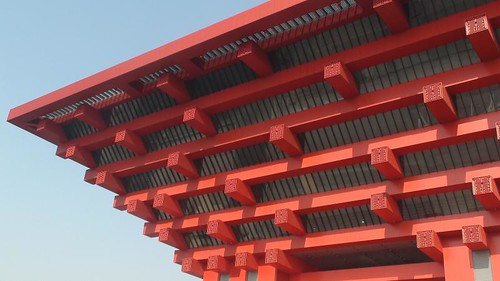
See more pictures in this article dedicated to this Pavilion.
Australian Pavilion
I will also have another dedicated article on this Pavilion. Thanks to the invitation and accompany of Peter, Sarah, and Lina to make my trip to Shanghai Expo Site the second time possible.

Japan Pavilion
It was a great surprise to me that I found out the Japanese Pavilion of Shanghai Expo 2010 is actually purplish. I read a lot about the holes, and the “ears” of this living architect, but I remember it was always white in most publications.

Photograph by Jian Shuo Wang
I was not able to take a full picture of this building – how can I for any of the pavilions under construction in the Shanghai Expo construction site. Here are some overview and preview of what the pavilion may look like in near future.
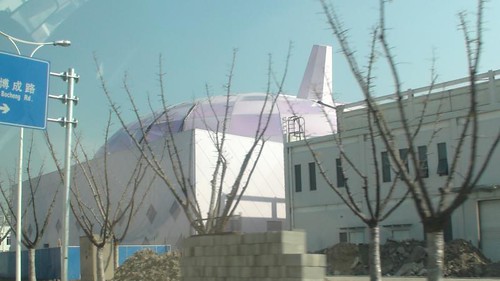
Photograph by Jian Shuo Wang
The photo was taken on December 19, 2009.
As of December 19, 2009, the French Pavilion made great progress. Look at this:

Photograph by Jian Shuo Wang
It reminds me of the architect of Centre National d’art et de Culture Georges Pompidou. Very industrialized, and aggressive visual design.
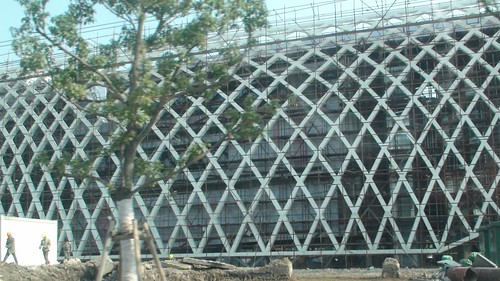
Photograph by Jian Shuo Wang
African Pavilion

Photo by Jian Shuo Wang

Photo by Jian Shuo Wang
Canada Pavilion

Photo by Jian Shuo Wang

Photo by Jian Shuo Wang
Photos of the Luxenburg Pavilion, as of December 19, 2009:

Photo by Jian Shuo Wang

Photo by Jian Shuo Wang
They put big character of the name of Luxenburg in Chinese, and “Small is Beautiful” on the surface of the building.
This is very impressive small architect.
Baosteel Stage
There will be daily performance there.

Malaysian Pavilion
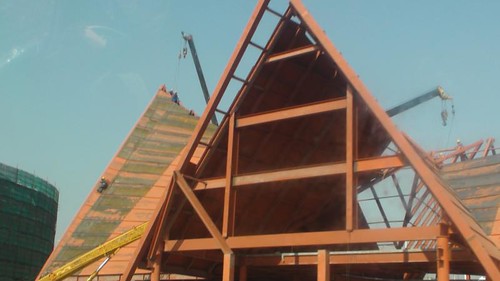
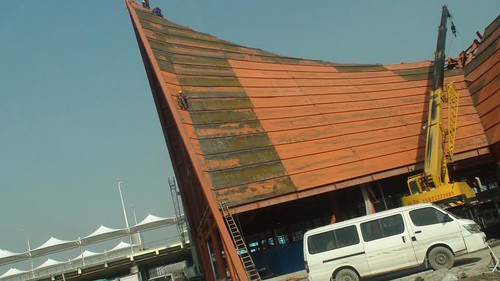
This is Korean

UFO – the Expo Performing Center
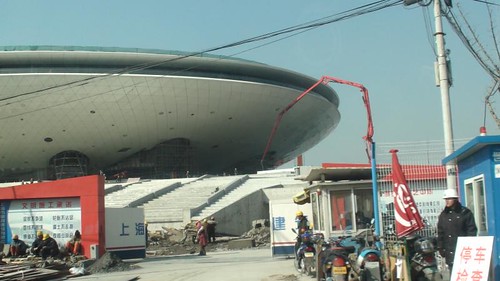
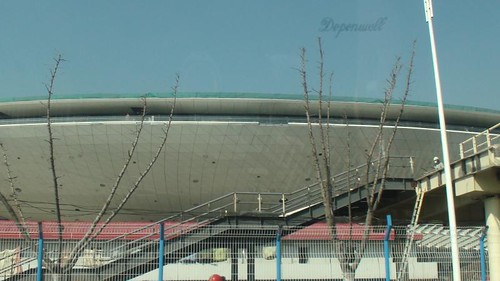
Expo Center
The blocks reminds me of the French Pavilion, but it is smaller, less aggressive, and modest.

Tailand Pavilion
You can easily guess what pavilion it is:
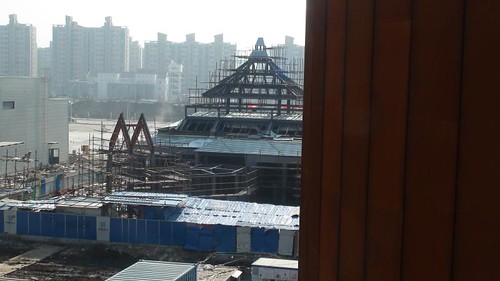
Singapore
I thought it is a maze, but it isn’t. It is the base structure of a building.

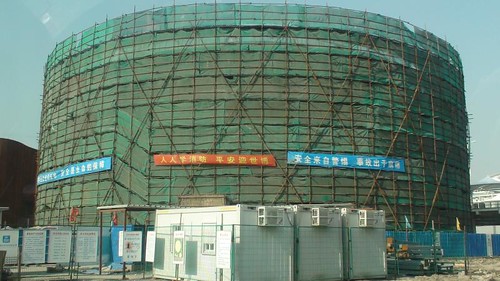
Amazing site! Looking forward to participating in the Expo the next year.
Great Progress of China Pavilion
The Shanghai Expo is 130 days to come. Thanks to the invitation of Peter and Lina from Australian Pavilion, I had the chance to visit the Expo site way ahead of its opening.
Here is the photo I took at the foot of the China Pavilion of Shanghai Expo 2010.
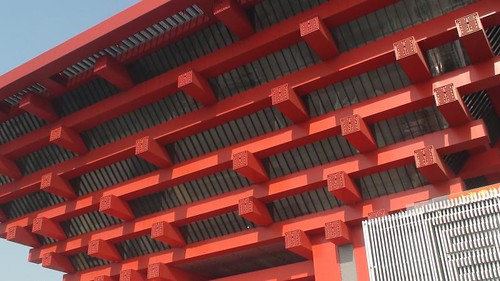
Image by Jian Shuo Wang
Above is the fresh red facade of the China Pavilion – the Oriental Crown. At the right lower corner is the surrounding buildings to the main architect.
At the edge of each big pole of the Pavilion, there is pattern like this. I still didn’t find out the meaning of the design yet – it seems like a good word in Chinese.
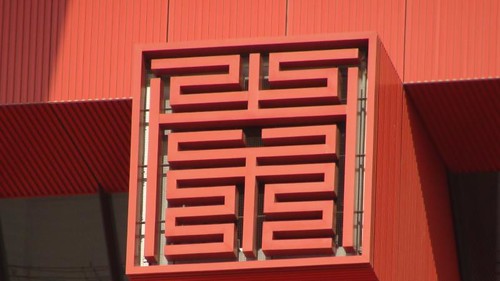
The corner of the big roof – the crown.

Below is the whole picture of the Pavilion.

Sorry for the blurry image – I took it from behind the window of the car.
My First Hand Impression
The pavilion is very nice – the red is better than saw on computer rendering image. The “forbidden city red” (how they named it) looks very fresh under the sky. I am very excited to see the huge building. It is not that big if you stand before it – a very approachable architect.
Looking forward to seeing you at the China Pavilion the next year!
Preview Australian Pavilion in Shanghai Expo
Visited Australian Pavilion of Shanghai Expo 2010 this morning with Wendy. I’d like to thank Peter, Lina and Sarah for the invitation and great accompany. As a blogger, I am always excited to be part of the development of this city, and share my first hand information with my readers worldwide. The Australian Pavilion project team obviously has been very nice to me to allow me to take a closer look at what is going on inside that highly secure guarded and mysterious Expo site. You will see my photos of the whole tour of many other pavilions (photo from outside) here: Preview of Shanghai Expo Site (Photos). Now, let me show you one of my favorite pavilions on the site: the Australian Pavilion.
You may always read my previous two posts about the Australian Pavilion. I feel happy to be involved in such an interesting project from the beginning, and see it develops to be better and better.
Australia Pavilion’s Construction Site
Australian Pavilion Foundation Completed
The Site
If you remember, the Australian Pavilion is at the corner of the Elevated Pedestrian, right under the Lupu Bridge. It is at the west side of the Theme Pavilion, with a big open ground in between. It is also at the exit of Metro Line #13 – great location!
Image taken from Australia Pavilion’s Construction Site
Hope this photo helps you to establish a sense of where the building is. I took this photo from the south of the pavilion, facing north. The Lupu Bridge is on the left (the elevated road), and Huangpu River is just north of the Australian Pavilion. If you are curious, the China Pavilion and the Expo Blvd is on the right (east).

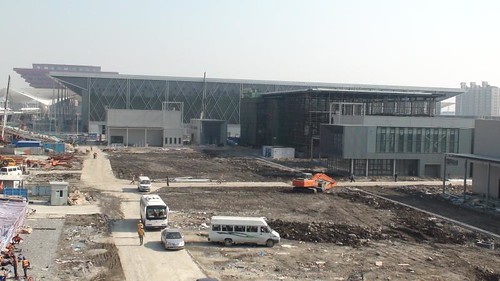
The big Australian in Chinese is shining on the south side of the building. It is where the main entrance is.

The Surface and the Steal
The facade of the Australian Pavilion is very special. I heard about the steel in the last time – its color changes along the time. Don’t be confused. The color of the steal is FINISHED! It is not like the rusty steel pending to be painted.
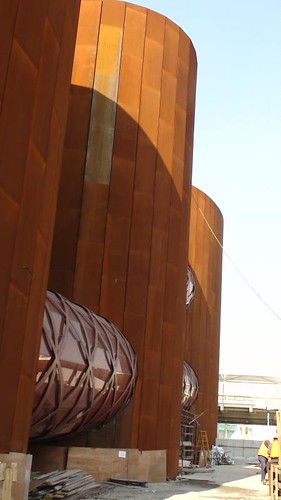

This is a closer look to the surface of the pavilion.

How about I tough it? The finger does get dirty – the rust, but very slightly.
The Journey Starts from a Tube
As you can see from this image, there is plastic tube surrounding the building.
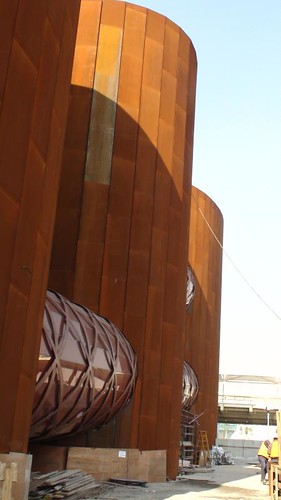
That is exactly how the visitors tour the pavilion. Entering the gate, you are in a big indoor open space, where people can gather and watch performance. On the right hand side, is the start of the huge tube. The journey to Australia starts here.

The tube is designed to allow 90 people to pass every minute. This is a must because there is a theater at the middle of the journey along this tube. It holds 1000 people and the show is about 10-12 minutes. That means, at the maximum, 1000 people may leave theater every 10 minutes.
Following Peter and Sarah, we entered the tube.

I like the design of Australian Pavilion a lot – it is just like the Gugenhaimn Solomon R. Guggenheim Museum in New York – there is no need for elevators. People use their own foot to walk along the slope inside the tube to get to the top and get down. I even took an impressionism photo of this tube.
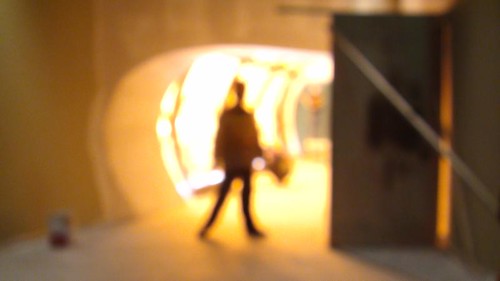
Tube and Shanghai
Inside the Tube, you are in Australia, and outside, it is Shanghai and the world. The tube is transparent in many sections.
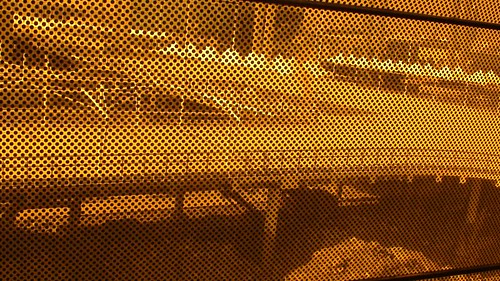
You can see the Lupu Bridge if you are at the west side of the Pavilion via the semi-transparent tube.
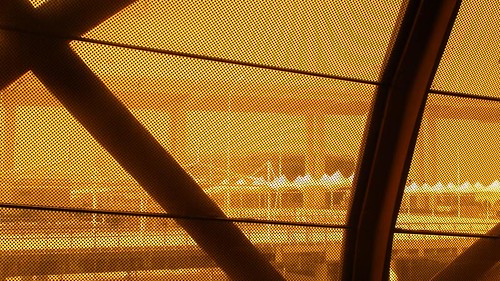
Surroundings
On the west and north side of the Australian Pavilion is the elevated pedestrian. Visitors can calmly walk on the car-free pedestrian and gain access to most of the pavilions.
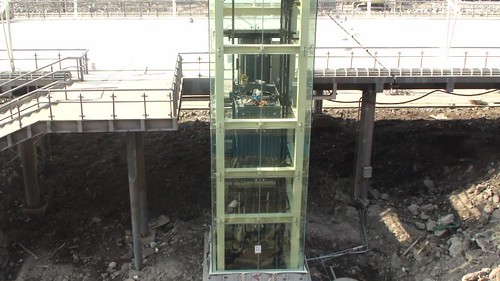
There is a metro exit right downstairs. It is said to be the line #13. Metro Line #8 and #7 are already opened, and there are two stations inside the Expo site, and the Line #13 will go east-west soon. The Expo site seems to be both good for walking and metro transition.
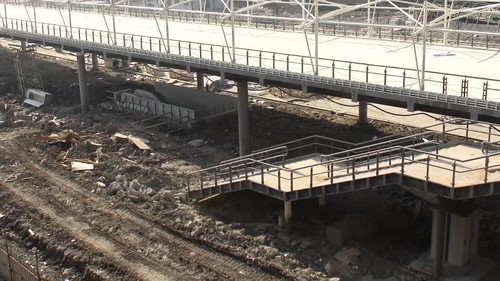
The Theater
On the north of the Pavilion is a theater. As I mentioned, it holds 1000 people. There are not seats inside – you can lean toward the poles to get rest to watch the 10 minutes show. It won’t be live show – just like a film with rotating screens.
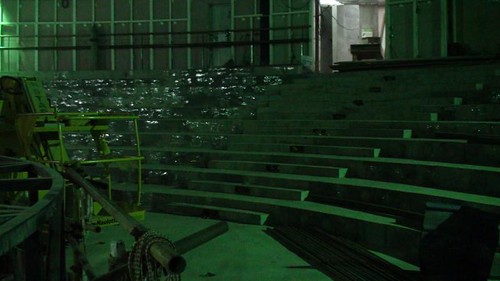
This is the stage. Obviously, it is not finished yet.
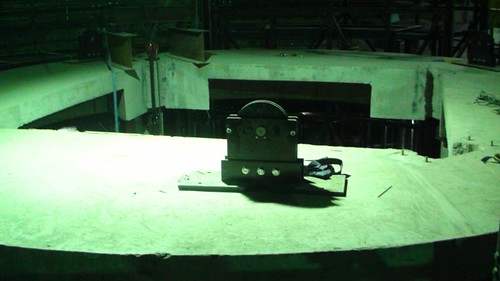
Installation of Exhibition Already Started
The Australian Pavilion team is taking every opportunity to lead the Shanghai Expo Pavilion constructions. They were the first to finish the foundation, the first to complete the main structure, and I guess maybe the first to start the installation of the exhibition. Look!

Looking Forward to the Party Time!
May 1, 2010 will be the start of the party. The hosts of each pavilion, like the Australian Pavilion, have been busy preparing for the party, and they worked really hard for it. Let’s give them the best wishes to have a smooth opening and let’s party in 2010 in Shanghai.
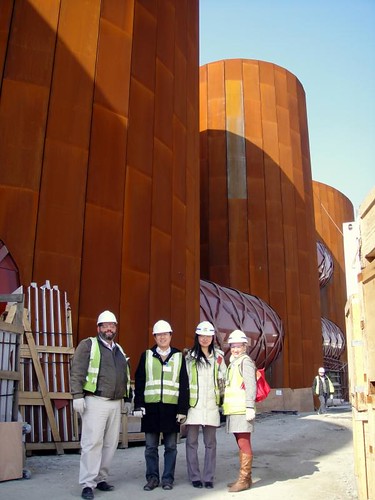
Photograph by Lina Han
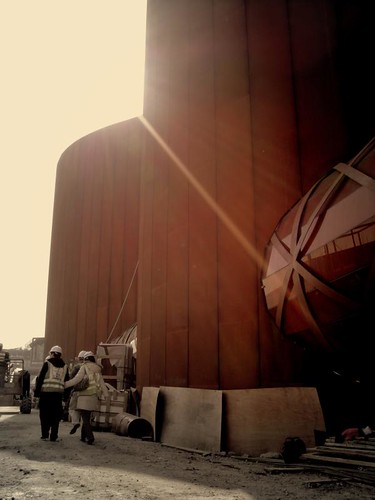
Photograph by Lina Han
Thanks Wikepedia
I read Jimmy Walls’ letter on donations to Wikipedia. A very good one.
I donated $35 to the Wikimedia Foundation to show my little help to them keep the good work, and sharing information. I am a proud supporter of Wikepedia, and hope you can do it too. You can donate with Paypal.
No Domains for Individuals in China
In the recent years, regulations come out like jokes. Everyday there are some national level regulations coming out to shock everyone – just like the jokes does, but not that fun.
From 9:00 December 14, 2009, no individuals in China can register a domain name in China. The interesting thing is, it is just a regulation for the Chinese domain registars. Anyone can easily register a domain via Internet from foreign providers like GoDaddy.com.
They believe by controlling who can register domains, they can control the whole Internet.
I am not Computer Science Major
When I have to write algorithms related code, I feel the limitation of my knowledge. From time to time, I need to turn to Wendy for help. She does not like to code as I do, but she completed 6 years of under-graduate and graduate study in Computer Science from Jiaotong University. I didn’t. My major was Automation, not pure computer science.
I have been puzzled by this for three days. Is there any chance that my readers can help me to solve this puzzle?
I have used query builder to create two structured query tree: q1, and q2.
I want to know whether the set represented by q1 is a subset of q2 or not.
Example in PHP:
$q1 = new AndQuery(new Query(‘id’, 123), new Query(‘age’, 13));
$q2 = new Query(‘age’, 13);
echo $q1->isSubsetOf($q2);
I need the function of “isSubsetOf”.
In the example, it should return true, but the real world situation is much complicated than that.
The need for such a function is, I have several search database optimized for each use, and each of them is represented by a query. For any user issued query, I can compare the query and the existing datastores. If I can confirm that the query result is subset of a datastore, I can safely use it to speed up the return of the results.
Yifan and Questions
In his current age, Yifan loves to ask questions all the time. The typical types of the questions are: “What” and “Why”.
Sample questions:
What is this?
What is on this?
Why this stone is red?
Why this brick is missing?
Why there is no gas hole on train?
Why are you standing here?
Why look at me?
Why….
Obviously, he is trying very hard to form an inner mapping of the external world in his brain. He is exploring curiously, and learning happily.
Yifan and Mobile Phone
Yifan found mobile phone easier to use than pen, computer, and chopsticks.
His morning routine is to grab my mobile phone and started to input numbers. His favorite is 8. He enters 16 eights (the length limit) and asks me to help him clean it up. Later, when he learned to use the clear key to clean the numbers, he loves the mobile phone better.
His mom recorded a nice folk song Jasmine by herself on her mobile phone. At night, Yifan loves to have the mobile phone, and play the song of his mom. Wendy and I cannot keep from laughing when we hear him play the song again – a big relief to Wendy. Thanks for the new technology. I asked Wendy: “Do you think he can fall asleep with the mobile phone”. Wendy said “no.” She is right. After Yifan is tired of the high-tech equipment, he still reaches out to the low-tech mom to sing for him, so he can feel safely fall asleep.
Another surprise to me was, one morning, I wake up to hear Yifan talking with someone over phone. It turned out that Yifan dialed his grandmother’s phone just by random pushing, and then was happy to hear his grandmother’s voice from it.
Oh. Yifan started to go to kindergartner from few days ago. He cried initially, and complained that the lunch is not as good as home, but he loves to play the big toys in the kindergartner. Still, he is introverted and don’t like to interact with other children. His grandfather said, it is just like me when I am in his age.
Early Wake Up
Following up yesterday’s post about common sense “Go to bed early, and wake up early make you a health man”, I went to bed at 10:00 AM and wake up at 7:00 AM. Spent about an hour to write some sample code (so good to use less lines of code to archive more). Then I did some planning work for the next few weeks. Yes. It seems right and nice to have the future life in control.
I said about ENFP is incompatible with GTD. I still believe so, but every type of personality loves to follow habits. I have also written about Fengshui = Convenience + Time. It is the counterpart of habits: environment. Both environment and habits promote accumulation of small things over long enough period of time so that to yield huge impact.
Habit also don’t have a starting and ending point. It is just like a moving object following its track, unless some external force changes it route. It is the most energy effective way to form a good habit and create a favorable environment for long lasting results.
I Would Have Written Less if I Had More Time
Paul told me that Mark Twain once said “I would have written less if I had more time”. What a great idea – echos what I believed in the programming space: Less is More in Coding.
Common principles are very common looking. Like the old saying to tell people to “Be good”! Commonly looking, and you don’t even noticed that people said that. The good idea is to follow the common principle, since it is more likely to reflect the truth.
In the training, we talked about the universal principles, and everyone of us tried to give examples. The mostly commonly approved principle by the class are the most common looking ones. The leading two:
1. It hurts when the head hits the wall.
2. If you don’t eat, you will be hungry.
We laughed at what we found after 10 minutes of brain storming. The truth about this is, if you read something that is so common, and self explanatory, and you take it for granted, you’d better follow it – the more common and naive it is, the more reliable it is.
So, in real life, less is more. Don’t try to find out those fancy quotes. Just follow the common sense.
I am now following my common sense: Go to bed early, and wake up early makes people healthy.
Good night and have a good dream.
Weekly Routine as Big Stone
One concept of 7 habits in Habit 3: Put First Things First is to put the big stones in life into our daily life first, before thinking about other smaller stuff. What I learned from Leo of Zen Habits was, to give every day of the week a name, and you focus on that on that day. Leo has 7 days in a week (I do too), and he assigned names like day of health, the day of productivity to each day, and he writes a blog on that topic on that day. This is actually a powerful idea. If you follow it, after few months, you will find yourself writing pretty balanced topics across all the categories, not just few of them.
It inspires me a great idea – to name each day of both private life and professional life a name. The key is to find 7 most important things in this stage of life, and really work on it on that day. It is not that the whole day is just for one goal, but it can provide a focus, and help on planning – you know exactly when that task/appointment/event should happen.
For example, I am thinking about assigning every Thursday as Technology day for me – in both professional and personal life. On the professional side, it is a good idea to arrange a code review, refactoring process, or just tech talk on that day for the team, and review the problems of the whole product, and to archive smaller code base. On the personal side, there are many things to follow and to understand on the technology side. It may be a good idea to work on it at home. At least, it is a good choice to fix my printer, or camera, or understand how to use the new equipment, or read something around technology.
Another example, Saturday may be a good choice for Family Day. Spend more time with friends, family together, make phone calls, and spend qualified time together… Go to movie with Wendy or play on the grassland with Yifan (well, Yifan prefers to go to big shopping malls better).
I hope that helps me to balance the life, and put priority stuff first.
Metro Line #7 Opens (with Pictures)
Metro Line #7 finally opens yesterday on December 5, 2009, at 9:00 AM. I took this afternoon taking the Metro Line #7 and took some photos.
Overview of the Metro Line #7
Shanghai Metro Line #7 is an orange line – the color of this line. It goes from Meilanhu on the northwest of the city to Huamu Road on the southeast. The completed line #7 will have 33 stations, but currently, only the stations between (including) Shanghai University and Huamu Road are open.
Here is a list of the stations of this metro line:
- Meilan Lake
- Luonan Xincun
- Panguang Road
- Liuhang
- Gucun Park
- Qihua Road
- Shanghai University
- Nanchen Road
- Shangda Road
- Changzhong Road
- Dachang Town
- Xingzhi Road
- Dahuasan Road
- Xincun Road
- Langao Road
- Zhenping Road
- Changshou Road
- Changping Road
- Jing’an Temple
- Changshu Road
- Zhaojiabang Road
- Dong’an Road
- Chuanchang Road
- Houtan
- Changqing Road
- Yaohua Road
- Yuntai Road
- West Gaoke Road
- South Yanggao Road
- Jinxiu Road
- Fanghua Road
- Longyang Road
- Huamu Road
The importance of this line is, that it connects many lines together. It can interchange to line #1 at Changshu Road, to Line #2 at Jing’an Temple and Longyang Road, and Line #3/#4 at Zhenping Road, Line #9 at Zhaojiabang Road, and many other lines in the future.
Photos of the Shanghai Metro Line #7
Below: This is the orange cart of the orange line.
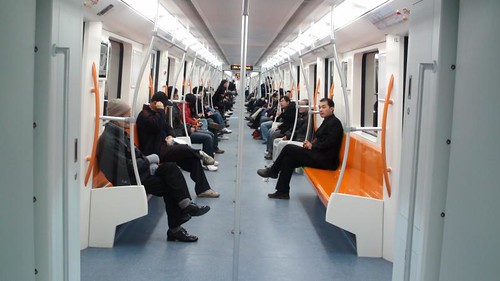
Below: the problem with Line #7 is, it is still not very easy to transit between lines. Although it is not as bad as Metro Line #1 and #2 at the People’s Square Station, it cannot be called close. These three photos shows the transition tunnel and the elevator between Metro Line #2 and Metro Line #7 at Long Yang Road Station. I won’t complain about the distance, but won’t be happy about it either.
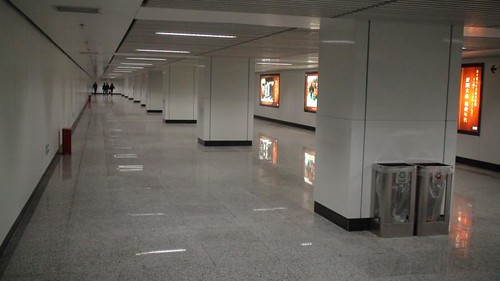
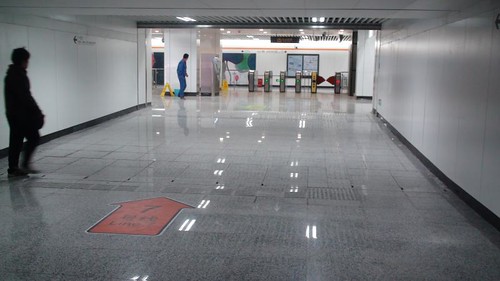
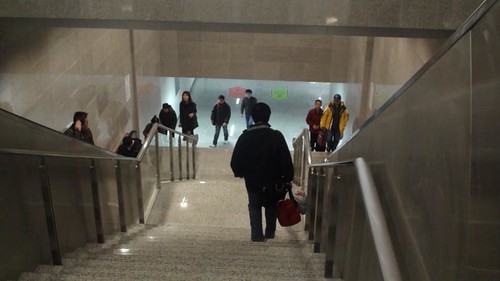
Construction is still going out outside the station to have the final work finished.
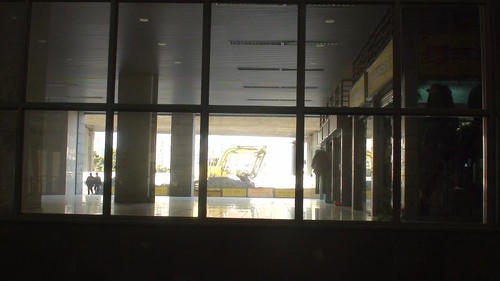
Below: The colorful seat with green designates the seat for disabled.


Good thing is, the Line #7 is completely equipped with glass walls.
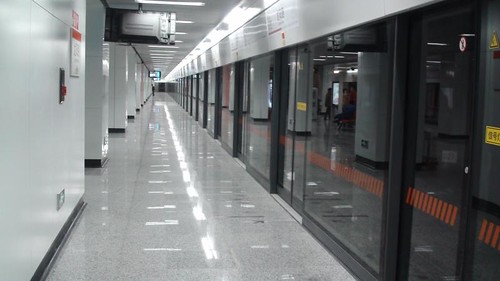
Huamu Road Station, the terminal station of Line #7 is the gate to the Shanghai International Expo Center. It has the best station design I saw along Metro Line #7 so far. It has the two levels connected with a big courtyard in the middle. All the other stations are, hmmm, just stations.
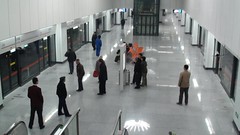
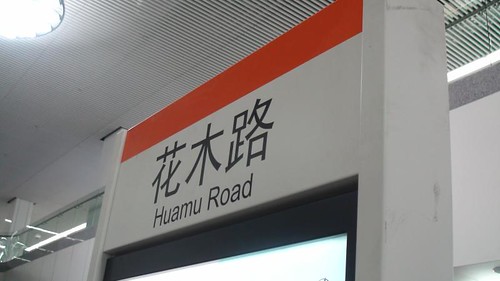
Look at this amazing Shanghai Metro Map. For a city with just 15 years of Metro history, this is very quick.
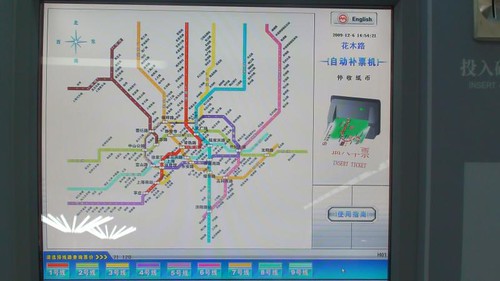
The Metro Line #7 is equipped with restrooms. Yeah!
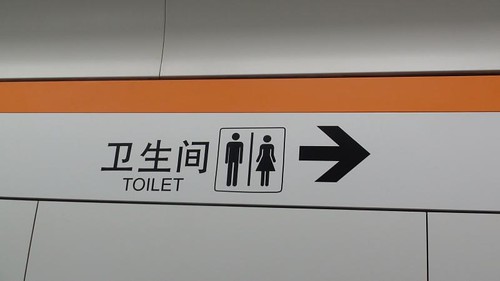
There are more equipments than other lines. Look at this. They even have two vendor machine inside the paid zone of the station, so people can help themselves to make up the shortage of ticket if they didn’t buy enough value.
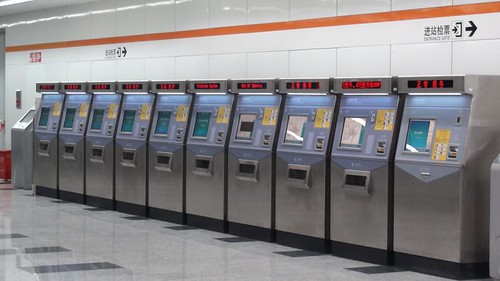
The service center is also more modern than other lines.
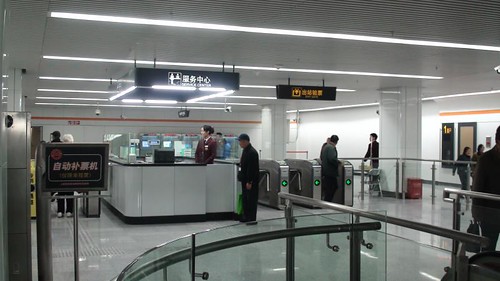
People are Excited
With just one line running from Hongmei Road to Shanghai Railway Station, I can remember the name of each station and their exact order. I can even tell the station from the decoration – the color and seats in the waiting area when I just came to Shanghai. Now, about 100 stations are there, and I can hardly been to half of them, and even cannot remember all of them.
Before, there was just one transit station – People’s Square, and later, with the network of Metro System extends, there are more and more transit stations, and now, it seems there are less stations which are not transit stations in the urban area of Shanghai than those are not.
I brought Yifan to the system today. He is so excited. Besides the metro staff who are there on duty, Yifan is always another person who wait until the train went out of sight before moving an inch. For two days, Yifan fall asleep on metro trains. He just don’t want to leave the subway system – just like his father.
Less is More in Coding
There is a saying within eBay that the lines of codes of eBay is more than Windows and Linux combined. Well… It is not a compliment from where I stand. The less the code is, the more powerful it can be.
With OOP (Object Oriented Programing), and the right level of abstraction, code can be very simple, very concise, easy to read, but remain more flexible and powerful. I spent the last few weeks rewriting some code with one principle in mind – just to push the limit to have less code. I have successfully turned a 2000 lines code into 250 lines, and another few thousands into 250 lines. I just feel 250 lines of code is a magic number to accomplish a lot. My goal of writing PHP code is, put less than 7 lines (ideally 3 lines or 1 line) into a function, and as less function as possible, while still maintain a very high level of flexibility and functionality. I believe one day I will share some sample codes.
Retaliating and Forgiving
It seems this Sunday morning is a perfect time to do something mental work (Yifan and Grandpa are in the park, and Wendy is in university studying). I want to continue to think about the topic of retaliating and forgiving as I first mentioned in this article: The Reason to be Friendly – Part II.
I am not a big fan of hate – I am always so. It seems more natural for me to forgive, but not so easy to retaliate. (Strange person, isn’t it?) But the game theory and the X, Y game I played the other day is a time changer, and I started to see the need for retaliating (or a better way to put it, the need for balancing retaliating and forgiving).
Retaliating is the punishing force to keep everyone playing friendly card. Without retaliating, the X player will always win, and there is no way to fix the problem, and thus hurting the whole society. In our real example, our team played an always-forgiving-never-retaliating role, and ended up with the lowest score (-$38). Although we claim spiritual success, it is a real failure in cash. It is the same for other two Y teams.
With the right retaliating, you help to keep the society stable. With the right retaliating, the “bad guys” are punished, and thus turn them into good guys in the future. A prisoner’s dilemma without retaliating is a complete disaster for everyone, except the defector.
Tit for Tat
The problem with old wisdom and idioms are, they only state part of the truth, and they conflict each other. There is saying of “an eye for an eye and a tooth for a tooth”, and there is another saying “If anyone strikes you on the right cheek, turn to him the other also.” How confusing it is!
Now, I read it as the balance of retaliating and forgiving. We cannot just do the one side. People need to the power of courage (to be strong and ready to fight) and the power of empathy (to be ready to forgive). Maybe something in the middle is, a tit for two tats.
My major was automaton in university. I didn’t learn too much from the automation theory, but one thing I remembered was, you have to add some attenuation in a feedback system to keep the system stable. A tit for tat strategy is not attenuation strategy. At least, we should apply 99% tit for a tat strategy in this world.
P.S. I do want to create a small computer program to prove the tit for tat strategy.
